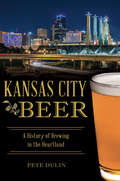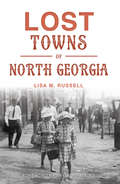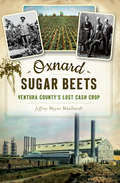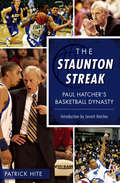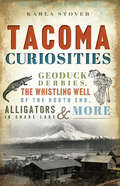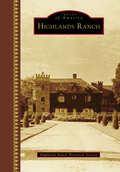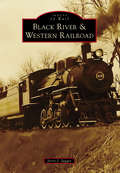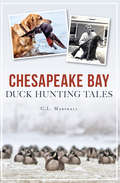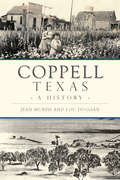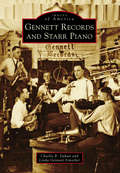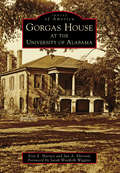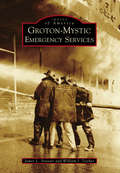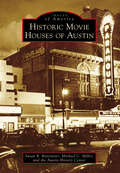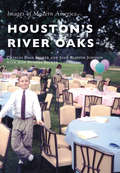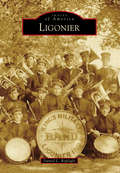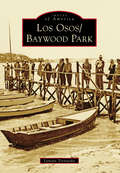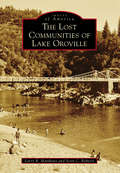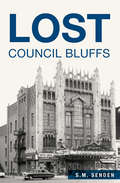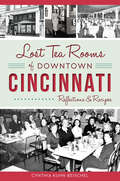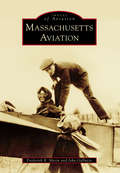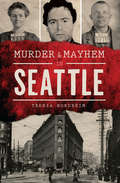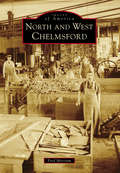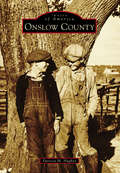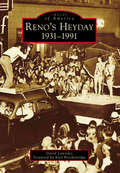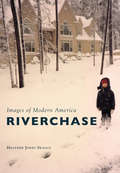- Table View
- List View
Kansas City Beer: A History of Brewing in the Heartland (American Palate)
by Pete DulinWestbound immigrants, pioneers and entrepreneurs alike arrived in Kansas City with a thirst for progress and beer. Breweries both small and mighty seized opportunity in a climate of ceaseless social change and fierce regional competition. Muehlebach Brewing Company commanded the market, operating in Kansas City for more than eighty years. Built in 1902, the iconic brick warehouse of Imperial Brewing still stands today. Prohibition made times tough for brewers and citizens in the Paris of the Plains, but political "Boss" Tom Pendergast kept the taps running. In 1989, Boulevard Brewing kicked off the local craft beer renaissance, and a bevy of breweries soon formed a flourishing community. Food and beer writer Pete Dulin explores Kansas City's hop-infused history and more than sixty breweries from the frontier era to the twenty-first century.
Lost Towns of North Georgia (Hidden History)
by Raymond Atkins Lisa M. RussellWhen the bustle of a city slows, towns dissolve into abandoned buildings or return to woods and crumble into the North Georgia clay. The remains of numerous towns dot the landscape--pockets of life that were lost to fire or drowned by the water of civic works projects. In 1832, Auraria was one of the sites of the original American gold rush. Cassville was a booming educational and cultural epicenter until 1864. Allatoona found its identity as a railroad town. Author and professor Lisa M. Russell unearths the forgotten towns of North Georgia.
Oxnard Sugar Beets: Ventura County's Lost Cash Crop (Lost)
by Jeffrey Wayne MaulhardtIn the early 1890s, farmers Albert Maulhardt and John Edward Borchard discovered Ventura County's favorable conditions for a highly profitable new cash crop: the sugar beet. Not long after inviting sugar mogul Henry T. Oxnard to the area, construction began on a $2 million sugar factory capable of processing two thousand tons of beets daily. The facility brought jobs, wealth and the Southern Pacific rail line. It became one of the country's largest producers of sugar, and just like that, a town was born. Despite the industry's demise, the city of Oxnard still owes its name to the man who delivered prosperity. A fifth-generation descendant, local author and historian Jeffrey Wayne Maulhardt details the rise and fall of a powerful enterprise and the entrepreneurial laborers who helped create a city.
The Staunton Streak: Paul Hatcher’s Basketball Dynasty (Sports)
by Jarrett Hatcher Patrick HitePaul Hatcher won 897 games as the head coach of the Robert E. Lee High School boys' basketball team in Staunton. Astoundingly, he won 85 in a row from 2003 to 2006. In a career spanning forty-three years, Hatcher won four state titles, was named coach of the year an amazing eleven times and is a member of five halls of fame. The beloved mentor also developed nationally recognized talent like Kevin Madden and Tyler Crawford. Author and journalist Patrick Hite presents the dramatic story of a legend in high school basketball history.
Tacoma Curiosities: Geoduck Derbies, the Whistling Well of the North End, Alligators in Snake Lake & More
by Karla StoverWhen the Northern Pacific Railroad laid its final tracks within the fledgling hamlet of Tacoma, it brought opportunity and wild characters by the car full. Seemingly overnight, the quiet Puget Sound village transformed into a booming metropolis and eccentric playground with its fair share of growing pains. On one unlucky evening, residents awoke to the cries of a man who fell into the sewers after a road collapsed. Tacoma's first school avoided demolition for a time thanks to a band of enterprising tramps who converted the place of learning into Hotel de Gink, complete with unique minstrel show. Local author and guide Karla Stover explores these and many more stories of the quixotic and curious history of the City of Destiny.
Highlands Ranch (Images of America)
by Highlands Ranch Historical SocietyHighlands Ranch, part of Douglas County, is known as one of the fastest growing communities in the nation. Highlands Ranch grew from the Colorado plains through a series of settlements starting in 1859, with most homesteaders arriving in the 1880s. The homesteads were eventually unified into one grand ranch and mansion. The 1980s began the transformation from a ranch to a community when Mission Viejo started building a master planned community. Today, Shea Homes has almost completed the build out of the area. The people, businesses, and organizations of Highlands Ranch have come together to create an enjoyable community and lifestyle that around 100,000 people call home.
Black River & Western Railroad (Images of Rail)
by Jerry J. JaggerThe Black River & Western Railroad has provided over 50 continuous years of passenger excursions in rural New Jersey between Flemington and Ringoes, passing through the pristine scenery of Hunterdon County. May 16, 1965, was the first official day of steam-powered passenger excursions, and 50 years later, on May 16, 2015, the same steam locomotive provided power for another steam-powered excursion. During those years, the railroad has grown from the simple excursion attraction of historic railroad equipment, providing the public amusement, to a regional short-line railroad.
Chesapeake Bay Duck Hunting Tales (Sports)
by C. L. MarshallIt takes stubborn dedication and passionate optimism to brave the frosty, wet conditions for the chance to shoot ducks and geese. And yet the tradition continues every year as more than one million waterfowl occupy the waters of the Chesapeake. Whether you are setting decoys or watching the sun rise from a blind, hunting the bay is as challenging as it is rewarding. No one understands that better than the generations who have experienced it, from the goose pits of Rock Hall and Chestertown to the frothing whitewater of the Tangier Sound. Join author and hunter C.L. Marshall as he recounts more than forty years of stories and anecdotes chock-full of dogs, good friends and fast-paced waterfowl action.
Coppell, Texas: A History (Brief History)
by Jean Murph Lou DugganCoppell history is rooted in peace and community. In 1843, Sam Houston met with ten native tribes along Grapevine Springs Creek to negotiate an accord to end fighting and allow trade and settlement in the area. When Dallas/Fort Worth International Airport opened in 1974, Coppell transformed from a farming hamlet into a thriving town with expanding economic opportunity. Through firsthand accounts with longtime residents and meticulous research, authors Jean Murph and Lou Duggan unfold the contemplative story of a complex and historic community.
Gennett Records and Starr Piano (Images of America)
by Charlie B. Dahan Linda Gennett IrmscherThe Starr Piano Company, based in Richmond, Indiana, quickly became one of the largest piano manufacturers in the United States during the 19th century. In 1915, the Starr Piano Company opened a recording division, Gennett Records, that led to a dynamic change in the music industry and American culture. Gennett embraced the vastly under-recorded genres of jazz, blues, and country music in the 1920s. They recorded artists who were groundbreakers and innovators in both popular and vernacular music, including Louis Armstrong, Charley Patton, Gene Autry, Hoagy Carmichael, Blind Lemon Jefferson, Uncle Dave Macon, and Jelly Roll Morton, often for the first time. The company, like many others, suffered a steep decline in the sale of their pianos and records due to the Great Depression, but the music recorded at Gennett continues to reach new generations and influence musicians as they discover it on reissues and streaming media services.
Gorgas House at the University of Alabama (Images of America)
by Jun A. Ebersole Sarah Woolfolk Wiggins Erin E. HarneyBuilt in 1829, the Gorgas House is the oldest structure on the University of Alabama campus. Originally constructed to serve as a hotel, housing for the university steward, and student dining hall, the building underwent several renovations to meet the needs of an ever-changing and growing campus. Later utilized as a faculty residence, classroom, post office, and infirmary, the Gorgas House was one of the few buildings to survive the destruction of campus near the end of the Civil War. Standing as a lasting reminder of the university's antebellum past, the house is preserved today as a museum dedicated to the legacy of the building's final residents, the Gorgas family.
Groton-Mystic Emergency Services (Images of America)
by William J. Tischer James L. StreeterEstablished in 1705, the town of Groton is geographically located between the Thames and Mystic Rivers in the southeastern corner of Connecticut. The town is comprised of eight separate subdivision communities that are referred to as fire districts. Groton is also the home to a large naval submarine base, a small general aviation airport, and several major industrial facilities, including the Electric Boat Corporation and Pfizer, Inc. The Mystic fire district is recognized for its historical maritime museums and facilities and plays host to thousands of tourists each year. At the present time, Groton and Mystic are provided emergency services by 13 fire departments, three police departments, two ambulance associations, one paramedic response unit, and one central dispatch operation.
Historic Movie Houses of Austin (Images of America)
by Austin History Center Michael C. Miller Susan RittereiserMotion pictures came to Austin on October 10, 1896, debuting at the Hancock Opera House. Since then, movies have continued to enchant, entertain, and inform the citizens of the capital of Texas. And, the places--the movie houses and theaters--where people saw motion pictures played just as important a role in the moviegoing experience as the movies themselves. As the city's population grew and motion picture technology changed, so too did Austin's movie houses, from the first kinetoscope parlor on Congress Avenue to the city' s first four-plex, the Aquarius 4, in southeast Austin. While most of these places are long gone, some withstood the test of time and are still showing movies or have been repurposed for other uses. Through the rich archival collections of the Austin History Center, Historic Movie Houses of Austin explores the stories of these important historic spaces and of the lives of those who were connected with them.
Houston's River Oaks (Images of Modern America)
by Ann Dunphy Becker Charles Dain Becker Joan Blaffer JohnsonRiver Oaks is a name that has rung out in Houston, Texas, since its founding in 1923. The neighborhood's uncertain geographical boundaries may be a point of controversy, but the impact River Oaks has had on the city is indisputable. River Oaks has been home to astronauts who have contributed to American space exploration; lawyers who are involved in the interworking of the United States' legal system; oil tycoons who have helped Houston grow; and doctors who are responsible for inventing lifesaving medical procedures. The neighborhood is also home to one of the country's most exclusive country clubs, and River Oaks has been served by some of the same schools, churches, stores, and restaurants since its founding. This book explores how River Oaks not only celebrates, grieves, and lives life day-to-day, but also how it changes the world.
Ligonier (Images of America)
by Daniel L. ReplogleIsaac Cavin, of Ligonier, Pennsylvania, traveled to Indiana in 1830. He returned home and married Elizabeth Marker in 1834, and they traveled together to northern Indiana. In May 1835, he planned a new town and named it Ligonier. He built his home a few miles north of town and lived there for 52 years. The next big players were two German Jewish peddlers, Solomon Mier and Frederick William Straus, who traveled to the United States and settled in Indiana. After training with their uncle, they moved to Ligonier around 1854 because they were told the railroad would be coming to Ligonier and that it might be a good place to start up a business. The suggestion led to some wonderful times for Ligonier. Straus developed one of his businesses into the largest farm brokerage firm in the United States, and Mier developed one of his businesses into one of the largest farmland dealers in the Midwest. Images of America: Ligonier explores one of the most unusual small towns in the United States.
Los Osos/Baywood Park (Images of America)
by Lynette TornatzkyLos Osos and Baywood Park, on the south end of Morro Bay, were two independent areas that developed separately during different periods. Over time, they grew together. In 1974, the US Post Office eliminated the Baywood branch and declared the area as Los Osos. Residents, passionate about their neighborhoods, specifically refer to Cuesta-by-the-Sea, Baywood, or the 12 other housing areas, while nonresidents ascribe to the Los Osos name. This area, including the beautiful Los Osos Valley, has been home to artisans, fishermen, and hunters for centuries, and more recently, cattle ranchers and farmers. The town grew haphazardly in fits and starts. Quirky, rebellious, off the beaten path--all apply. People here are happy to be a bit undiscovered and prefer that it stays that way.
The Lost Communities of Lake Oroville (Images of America)
by Larry R. Matthews Scott C. RobertsIn 1968, Lake Oroville flooded the West Branch, North Fork, Middle Fork, and South Fork canyons of the Feather River. Also inundated were the communities of Las Plumas, the Big Bend Power House, Bidwell Bar, and Enterprise. In 1994, Feather Falls Village, located above the lake, also ceased to exist due to a totally different situation. But all of these communities had one thing in common: there were people who had resided in them for decades and who still have an emotional connection to them. This book attempts to preserve some of the history of those areas and also tries to show some of what it was like to live in those now almost forgotten communities.
Lost Council Bluffs (Lost)
by S. M. SendenNestled in the Loess Hills, Council Bluffs grew from a frontier settlement of wickiups and log cabins. The outpost boomed as a gateway to the West when gold was discovered in California in 1849. The Pacific House and the Ogden House became landmark hotels for the transient population. Meanwhile, residents thrived and cultivated a bustling city with the Masonic Hall, Dohany's Opera House and the Merriam block. None of these once iconic buildings remains today. Author S.M. Senden explores the perpetual rebirth of Council Bluffs through its most important buildings and relates a still unfolding story.
Lost Tea Rooms of Downtown Cincinnati: Reflections & Recipes (American Palate)
by Cynthia Kuhn BeischelIt was a different time. Ladies wore gloves, hats and nice attire to luncheons at the Woman's Exchange. Shillito's provided a cosmopolitan environment for its patrons, while Mullane's was the perfect place to sip and socialize. The popular Good Morning Show radio program hosted by charming Bob Braun, and later Nick Clooney, was broadcast from McAlpin's Tea Room. Women gathered at Pogue's and Mabley & Carew tea rooms to celebrate birthdays, as well as wedding and baby showers, over dainty tea sandwiches. Author Cynthia Kuhn Beischel brings the Queen City's bygone downtown tea rooms back to life and shares more than one hundred beloved recipes.
Massachusetts Aviation (Images of Aviation)
by John Galluzzo Frederick R. MorinShortly after the Wright brothers took to the air, aviation fever gripped Massachusetts. The biggest names in the industry, including Wilbur Wright, Glenn Curtiss, and Claude Graham-White, among others, flew in for the first major air shows, further exciting the people of the Bay State about the potential of manned flight in the realms of military tactics, the expansion of commerce, and even personal transportation. By the 1920s, Massachusetts had become home to the first Naval Air Reserve Base, in Quincy; one of the first Coast Guard Air Stations, in Gloucester; and the Boston Airfield, which would become the largest international airport in New England. Within a few decades, individuals like Edward Lawrence Logan, Frank Otis, Oscar Westover, and Laurence G. Hanscomb would permanently leave their names on the Massachusetts landscape in connection with the airports and airfields still used today.
Murder & Mayhem in Seattle (Murder And Mayhem Ser.)
by Teresa NordheimSeattle harbors a dark and violent history that stretches back to a bloody battle between natives and settlers in 1856. In the early 1900s, Dr. Linda Hazzard stole money from countless patients after starving them to death in her infamous sanitarium. Three robbers opened fire in the notorious Wah Mee gambling club in 1983, killing thirteen people in the state's deadliest mass homicide. Some of America's most notorious serial killers wrought terror in Seattle, including the Green River Killer, Gary Ridgway. Ted Bundy's murder spree started in King County before reaching national attention in the 1970s. Local author Teresa Nordheim exposes these and many more gruesome events that scarred the city.
North and West Chelmsford (Images of America)
by Fred MerriamThe Massachusetts town of Chelmsford, chartered in 1655, consisted of five villages. In the 1820s, industries related to the production of cast iron, textiles, and textile mill machinery made their first appearance in the North village along Stony Brook. Its social and economic life became aligned with the new industrial city of Lowell, and there had even been talk of secession from the Centre village in the mid-1800s. A golden age of industrial expansion and production occurred from 1875 to 1910. Industry in the West village consisted of blade and textile manufacturing in two locations, also tied to water power on Stony Brook, but this community was aligned socially and economically with nearby Nabnasset village in Westford. Discover the golden age of the North and West villages in photographs and learn about the people who made it happen.
Onslow County (Images of America)
by Patricia M. HugheyOnslow County is one of the oldest maritime and agricultural counties on the southeastern coast of North Carolina. Originally inhabited by indigenous peoples, the area was settled in the early 18th century by a diverse group of people, including farmers, merchants, indentured servants, and slaves, hailing not only from nearby colonies but also from the British Isles and West Indies. This diversity has continued into the 21st century; Onslow's citizens have arrived from virtually every state and from several foreign countries due to the military presence of Camp Lejeune and New River Air Station. But there remains a nucleus population of families that descended from those early-18th-century pioneers--a thread that provides continuity into the present. These old-timers always appreciate and enjoy the history of their familiar surroundings, while newer residents want to learn more about the place they now call home.
Reno's Heyday: 1931-1991 (Images of America)
by David Lowndes Karl BreckenridgeFor 60 years starting in 1931, Reno was unarguably the place where things not possible elsewhere were its hallmarks--gambling, divorce, and uncomplicated weddings. Old promotional campaigns described two Renos--one for gambling and entertainment and one for outdoor activities. For locals, there were two other Renos. One was a beautiful city on a mountain river between towering peaks. It was a community of local businesses where people knew each other and were proud of its university. The other Reno was the city of casinos and top-name entertainment that attracted visitors. For most of those 60 years, the visitors' Reno increasingly crowded out the residents' Reno. But with the decline of the divorce and gambling businesses and the coming of new high-tech industries to Reno's economy, Reno's heyday may be just gearing up for a second wind.
Riverchase (Images of Modern America)
by Heather Jones SkaggsIf residents of the original c. 1900s mining town of Acton, Alabama, looked into the future, would they have imagined that the area would develop into the multimillion-dollar planned community it is today? In the late 1960s, John M. Harbert III (1921-1995), founder of Harbert Corporation, saw tremendous potential for land in Acton owned by the Chace brothers. In 1974, the Harbert Corporation partnered with Equitable Life Assurance Society of the United States to form Harbert-Equitable Joint Venture, Riverchase. This plan was not a concrete jungle of homes and businesses. The venture called for a careful blending of new development with its surrounding natural landscape. This plan spoke to man's need to be part of nature, albeit in a new and responsible way. Today, Riverchase is a picturesque community steeped in land preservation, business development, and community pride. The story of Riverchase is conveyed through the memories of its residents in Images of Modern America: Riverchase.
